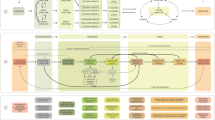Abstract
In this article a model is proposed that could be used as a basis for ecological planning of natural resources. The role of people as part of the ecosystem is emphasized, and the various factors that should be considered in such planning are discussed.
An understanding of ecological planning is dependent on the study of human activities in, and the nature of, natural ecosystems. It also depends on the fact that people are a part of nature, and as a result nature is of value to humans. Realizing the importance of this principle is a prerequisite to studying nature and also for an understanding of the various steps in the ecological planning approach.
Realization of these values is often through a series of activities that may result in a negative environmental impact. Nature is described as an interacting group of natural features and processes. In this study both the features and processes are described as natural resources. The use of these natural resources obviously affects them, and if this use is to continue over a long period, both the activity and the resource must be understood if they are to be maintained in a productive state. In order to limit impact and maintain value, a planning aid called zoning is used to assist in the understanding of the processes involved.
Similar content being viewed by others
Literature Cited
Cohen, U. A. 1971. Man in adaptation—the institutional framework. Aldine Atherton, Chicago. p. 478.
Duchart, I., F. Steiner and J. H. Bassman (undated). Planning methods for Agroforestry. Scientific Paper No. 7744. Washington State University, College of Agriculture and Home Economics, Pullman, Washington.
Hanks, J. 1983. International symposium: The extinction alternative: Conversation for development. Institute of Natural Resources, Pietermaritzburg. p. 9.
Hills, G. A. 1961. The ecological basis for land-use planning. Department of Lands and Forests, Ottawa, Canada.
IUCN (International Union for Conservation of Nature and Natural Resources). 1980. World conservation strategy United Nations environment program. Gland, Switzerland.
Juneja, N. 1974. Medford performance requirements for the maintenance of social values. University of Pennsylvania, Philadelphia, Pennsylvania. p. 63.
Lewis, P. H. 1969. Ecology: The inland water tree.American Institute of Architects Journal. 51:59–63.
McHarg, I. L. 1969. Design with nature. Natural History Press, p. 157.
Phillips, J. 1972. Ecology and ecological classification in relation to the conservation and use of land and water in Natal. Provincial Administration, Pietermaritzburg.
Smuts, J. C. 1926. Holism and evolution. Macmillan. London.
Steiner, F. 1983. Resource Suitability: Methods for analyses.Environmental Management 7(5):401–420.
Steiner, F. 1988. Landscape planning: A working method. Third Annual Landscape Ecology Symposium, Albuquerque, New Mexico.
Steiner, F., and K. Brooks. 1981. Ecological planning: A review.Environmental Management 5(6):495–505.
Steiner, F., G. Young and E. Zube. 1987. Ecological planning: Retrospect and Prospect.Landscape Journal. 6:31–39.
Tinley, K. L. 1977. Framework of the Gorongosa ecosystem. Wildlife management thesis. University of Pretoria, Pretoria, South Africa. p. 184.
Tinley, K. L., and W. F. Van Riet. 1975. Planning and management proposals for the Dwessa Forest Reserve: Transkei. Department of Forestry and Nature Conservation. Umtata. p. 88.
Tinley, K. L., and W. F. Van Riet. 1978. Pilanesberg National Park. Unpublished planning study. Government of Bophuthatswana. p. 70.
Tinley, K. L., and W. F. Van Riet. 1981. Tongaland: Zonal ecology and rural land-use proposals. The Department of Co-operation and Development, South Africa. p. 123.
Van Riet, W. F., and J. Cooks. 1990a. An Ecological planning proposal for the Kruger National Park.Environmental Management 14:000-000.
Van Riet, W. F., and J. Cooks. 1990b. The planning and design of Berg-En-Dal, a new camp in the Kruger National Park.Environmental Management 14:000-000
Author information
Authors and Affiliations
Rights and permissions
About this article
Cite this article
van Riet, W.F., Cooks, J. An ecological planning model. Environmental Management 14, 339–348 (1990). https://doi.org/10.1007/BF02394202
Issue Date:
DOI: https://doi.org/10.1007/BF02394202




